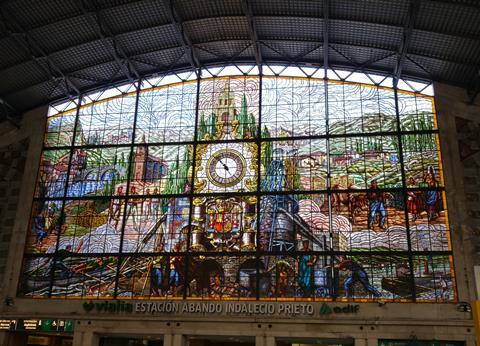
SPAIN: On March 11 the Spanish government announced that management of all suburban services in the Basque region would be transferred from national operator RENFE to the Euzkadi autonomous community.
The national government will set up a €400m fund to launch the project, some of which will be invested by Euzkadi in new trains. The state will meanwhile establish a dedicated body to oversee investment, and Euzkadi will cease to pay the central government its annual €92∙7m quota which is used to finance the suburban services.
RENFE currently has a contract to run 1 668 mm gauge local services in Bilbao and San Sebastián until January 1 2028. In the meantime, the Basque government will draw up timetables, develop a fares structure and plan for other improvements.
In Bilbao, the three RENFE suburban routes from Bilbao-Abando to Santurtzi, San Julian de Muskiz and Orduña carry around 42 000 passengers a day. To these must be added the former FEVE 1 000 mm gauge route from Bilbao-La Concordia to Balmaseda and La Calzada, which crosses the border into Burgos Province in Castilla-León; this service has been steadily losing traffic since the early 2000s. The only RENFE suburban line in San Sebastián is the route that runs from Irún to Zumarraga and Brinkola.
So far Euzkadi has given no indication of the identity of the future operator, though it is likely that this would be Euskotren, which has for some years expressed interest in the Balmaseda line. This would consolidate Euskotren’s metre-gauge network in the Bilbao area.
There are suggestions that the Basque capital, Vitoria-Gasteiz, may also develop its own suburban network.
National government opens the door
The move by the Basque regional government follows an announcement in early December 2023 by national Transport Minister Óscar Puente that he was open to all the autonomous communities taking over responsibility for suburban rail operations. Significantly, there have been numerous complaints in recent years about the quality of rail services in the Basque region provided by RENFE and infrastructure manager ADIF.
The minister’s announcement also triggered a positive response from Andalucía, which has suburban networks in Córdoba (Metrotrén), Sevilla and Cádiz; some interest was also expressed by Asturias.
Puente ruled out setting a timescale for any transfers, considering that it would be better for each community to make its own plans. He also reassured RENFE employees that their interests would be respected.
In the previous month Salome Pradas, Infrastructure Councillor at the Generalitat of València, had ruled out taking over RENFE’s local suburban services on financial grounds, considering that such a move would be ‘unreal and irresponsible’.
Other regions
Back in the 1970s and 1980s three autonomous communities in Spain, Catalunya, the Generalitat Valenciana and Euzkadi decided to manage their local rail networks rather than see them absorbed into state-owned narrow-gauge operator FEVE.
Catalunya set up Ferrocarrils de la Generalitat de Catalunya in 1979 to absorb the 1 000 mm and 1 435 mm gauge networks serving Barcelona. Ferrocarriles de la Generalitat Valenciana dates from 1986, when it absorbed the 1 000 mm gauge lines in València and Alacant then already operated by FEVE.
No further regional takeovers took place until January 2005 when the government of José Luis Rodríguez Zapatero agreed to the transfer of the Lleida to Pobla de Segur branch to the Generalitat de Catalunya, which handed management to FGC. The line’s infrastructure was renovated and a small fleet of Class 331 DMUs was acquired from Stadler. Timetables were revised, and the line enjoyed increased publicity, leading to a ridership recovery. Daily traffic had fallen from 90 000 in 2000 to 60 200 in 2015, but by 2019 it had risen to over 251 500 and reached 372 200 in 2023. FGC’s target for 2028 is 432 000.
FGC is now set to take over suburban services from RENFE between Manresa and Lleida in 2025 using four FLIRT EMUs ordered from Stadler. In the future FGC will also take over services between Barcelona’s El Prat airport and the Catalan capital using a fleet of 10 EMUs on order from Alstom.
RENFE continues to operate other suburban and regional routes in Catalunya, but there are plans for a gradual transition over 15 years to an operating entity owned jointly by the state and the Generalitat, which will hold a majority stake. This is provisionally named Rodalies de Catalunya, and its geographical scope will include Lleida, Tarragona and Girona.

















